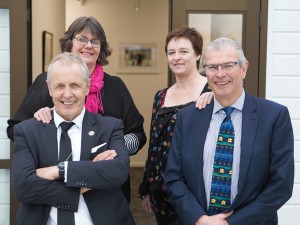Respiratory physician Lutz Beckert considers chronic obstructive pulmonary disease management, including the prevention of COPD, the importance of smoking cessation and pulmonary rehabilitation, and the lifesaving potential of addressing treatable traits. He also discusses the logic of inhaler therapy, moving from single therapy to dual and triple therapy when indicated, as well as other aspects of management
Budget misses mark on workforce: Rescue remedy needed as too few medical graduates ever specialise
Budget misses mark on workforce: Rescue remedy needed as too few medical graduates ever specialise

A positive disruption is needed to correct underinvestment in New Zealand’s regulated health practitioners, writes Sarah Dalton
Let’s get all our registrars into training programmes. Let’s make it clear there will be jobs for them on completion
The Budget in an election year is always big news. Unfortunately, this year’s provided little of what members of the Association of Salaried Medical Specialists were seeking.
While the end of prescription copayments is welcome, Budget 2023 failed to deliver on the critical staffing shortages in health – including retention and training. It leaves me wondering when and how we will see a positive disruption in the long-term pattern of underinvestment in our regulated workforces.
At the start of the workforce pipeline, New Zealand has, for many years, lagged behind the OECD average for medical graduates per 100,000 people, and that gap has only widened more recently.
This creates an obvious risk to the sustainability of our workforce.
In 2017, the then Health Workforce New Zealand noted that, in just over half of specialties, there were fewer registrars in training than senior medical officers aged 55 or over. Disappointingly, collection of the data was discontinued soon afterwards.
Subsequent analysis by ASMS has found the situation in 2020 was only getting worse and 28 out of 36 specialties had fewer trainees than specialists (both private and public) aged 55-plus.
To even begin to keep up, ASMS estimates, New Zealand would need an extra 300 graduates placed by 2027.
As well as too few medical graduates entering the pipeline, we lose a further 10 per cent in their first seven years. Then, between a third and half don’t go on to complete specialist training programmes.
Unpublished data from the Medical Council for each year from 2004 to 2011 show a gap between the number of graduates and the number who eventually become specialists by 2022, ranges from 32 to 48 per cent.
Again, Health Workforce New Zealand raised this as an area of potential concern in 2017 but said a lack of data made it unclear whether this represented “a long-term deficit or risk to service delivery”.
In 2018, unpublished Ministry of Health data showed 29 per cent of full-time-equivalent registrars were not in a specialist training programme. At the same time, increasing numbers of “establishment FTE” registrar training positions were not being filled across many specialties.
But, in another blow, the ministry stopped collecting these data as well, and the risk to service delivery was never investigated further.
It is essential that we understand why these trends are occurring. Are “establishment FTE” training positions not being advertised? Is trainer capacity overstretched? Can trainee applicants not find suitable positions in their preferred speciality and location? Or are funding constraints driving these trends?
Let’s get all our registrars into training programmes. Let’s make it clear there will be jobs for them on completion of training. Let’s do everything we can to keep our resident medical officers living and working here in Aotearoa.
Te Whatu Ora’s Workforce Taskforce seems to have turned its collective gaze away from data sets, burning questions, and the wicked problems that increasingly characterise our regulated health workforce.
Attempts to render GP training more attractive are being delayed. With Te Whatu Ora the employer, an increase to GP registrars’ salaries won’t happen until 2025. The complicated arrangements that characterise funding to and supply of community-based health remain a mess. There is no sign that this will change under Te Whatu Ora’s nascent commissioning model.
We need to have better conversations about thorny issues like generalist and sub-specialised training, healthcare delivery in public and private settings, how we manage provision of and intersections between community and hospital-based care, virtual care and, importantly, safe and sustainable work.
The more we test each other on these things, the richer the conversation, the stronger the advocacy and, I like to think, the better the outcomes.
This work will take effort by all of us and it will require funding to be found. And that is where government budgets come into play.
Unfortunately, it would seem that Budget 2023 wasn’t game enough.
Sarah Dalton is executive director of the Association of Salaried Medical Specialists Toi Mata Hauora
We're publishing this article as a FREE READ so it is FREE to read and EASY to share more widely. Please support us and our journalism – subscribe here
One of the benefits of subscribing is you will also be able to share your thoughts about what you read with other in our Comment Stream. You can also take notes on what you read with Capture








![Barbara Fountain, editor of New Zealand Doctor Rata Aotearoa, and Paul Hutchison, GP and senior medical clinician at Tāmaki Health [Image: Simon Maude]](/sites/default/files/styles/thumbnail_cropped_100/public/2025-03/Barbara%20Fountain%2C%20editor%20of%20New%20Zealand%20Doctor%20Rata%20Aotearoa%2C%20and%20Paul%20Hutchison%2C%20GP%20and%20senior%20medical%20clinician%20at%20T%C4%81maki%20Health%20CR%20Simon%20Maude.jpg?itok=-HbQ1EYA)
![Lori Peters, NP and advanced health improvement practitioner at Mahitahi Hauora, and Jasper Nacilla, NP at The Terrace Medical Centre in Wellington [Image: Simon Maude]](/sites/default/files/styles/thumbnail_cropped_100/public/2025-03/2.%20Lori%20Peters%2C%20NP%20and%20advanced%20HIP%20at%20Mahitahi%20Hauora%2C%20and%20Jasper%20Nacilla%2C%20NP%20at%20The%20Terrace%20Medical%20Centre%20in%20Wellington%20CR%20Simon%20Maude.jpg?itok=sUfbsSF1)
![Ministry of Social Development health and disability coordinator Liz Williams, regional health advisors Mary Mojel and Larah Takarangi, and health and disability coordinators Rebecca Staunton and Myint Than Htut [Image: Simon Maude]](/sites/default/files/styles/thumbnail_cropped_100/public/2025-03/3.%20Ministry%20of%20Social%20Development%27s%20Liz%20Williams%2C%20Mary%20Mojel%2C%20Larah%20Takarangi%2C%20Rebecca%20Staunton%20and%20Myint%20Than%20Htut%20CR%20Simon%20Maude.jpg?itok=9ceOujzC)
![Locum GP Helen Fisher, with Te Kuiti Medical Centre NP Bridget Woodney [Image: Simon Maude]](/sites/default/files/styles/thumbnail_cropped_100/public/2025-03/4.%20Locum%20GP%20Helen%20Fisher%2C%20with%20Te%20Kuiti%20Medical%20Centre%20NP%20Bridget%20Woodney%20CR%20Simon%20Maude.jpg?itok=TJeODetm)
![Ruby Faulkner, GPEP2, with David Small, GPEP3 from The Doctors Greenmeadows in Napier [Image: Simon Maude]](/sites/default/files/styles/thumbnail_cropped_100/public/2025-03/5.%20Ruby%20Faulkner%2C%20GPEP2%2C%20with%20David%20Small%2C%20GPEP3%20from%20The%20Doctors%20Greenmeadows%20in%20Napier%20CR%20Simon%20Maude.jpg?itok=B0u4wsIs)
![Rochelle Langton and Libby Thomas, marketing advisors at the Medical Protection Society [Image: Simon Maude]](/sites/default/files/styles/thumbnail_cropped_100/public/2025-03/6.%20Rochelle%20Langton%20and%20Libby%20Thomas%2C%20marketing%20advisors%20at%20the%20Medical%20Protection%20Society%20CR%20Simon%20Maude.jpg?itok=r52_Cf74)
![Specialist GP Lucy Gibberd, medical advisor at MPS, and Zara Bolam, urgent-care specialist at The Nest Health Centre in Inglewood [Image: Simon Maude]](/sites/default/files/styles/thumbnail_cropped_100/public/2025-03/7.%20Specialist%20GP%20Lucy%20Gibberd%2C%20medical%20advisor%20at%20MPS%2C%20and%20Zara%20Bolam%2C%20urgent-care%20specialist%20at%20The%20Nest%20Health%20Centre%20in%20Inglewood%20CR%20Simon%20Maude.jpg?itok=z8eVoBU3)
![Olivia Blackmore and Trudee Sharp, NPs at Gore Health Centre, and Gaylene Hastie, NP at Queenstown Medical Centre [Image: Simon Maude]](/sites/default/files/styles/thumbnail_cropped_100/public/2025-03/8.%20Olivia%20Blackmore%20and%20Trudee%20Sharp%2C%20NPs%20at%20Gore%20Health%20Centre%2C%20and%20Gaylene%20Hastie%2C%20NP%20at%20Queenstown%20Medical%20Centre%20CR%20Simon%20Maude.jpg?itok=Z6u9d0XH)
![Mary Toloa, specialist GP at Porirua and Union Community Health Service in Wellington, Mara Coler, clinical pharmacist at Tū Ora Compass Health, and Bhavna Mistry, specialist GP at Porirua and Union Community Health Service [Image: Simon Maude]](/sites/default/files/styles/thumbnail_cropped_100/public/2025-03/9.%20Mary%20Toloa%2C%20Porirua%20and%20Union%20Community%20Health%20Service%20in%20Wellington%2C%20Mara%20Coler%2C%20T%C5%AB%20Ora%20Compass%20Health%2C%20and%20Bhavna%20Mistry%2C%20PUCHS%20CR%20Simon%20Maude.jpg?itok=kpChr0cc)